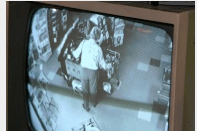There is nothing I truly hate to see more than the deputy coming in to serve me with a subpoena for shoplifter court. It’s not that I don’t like the man; he’s nice enough and it’s not his fault. I know deep down it is my own fault for not having any Antishoplifting tools and measures in place when the thefts occurred. In the reactive world we live in, we are more apt to fix theft problems after they happen the first time. So just this week I looked up to see my deputy friend walking in the door with that dreaded paper in his hand. I haven’t had any issues in a while so I actually thought he must have been looking for someone in the pharmacy. (I’m the front end manager of a small retail pharmacy, and we do have the occasional fake prescription or some other issue back there.) But to my dismay, I was the intended receiver of his summons.
This particular one is for superior court, instead of the usual lackluster criminal court shoplifter proceedings. Apparently, one of our incidents was bigger than we thought. A couple came in a year and a half ago on a night near closing, pushing a baby stroller. It was November so the fact that there was a blanket covering “the baby” was no red flag. My staff paid no mind to them, and continued vacuuming and other nightly recovery duties they were assigned to. Unfortunately, when I came into work the next morning I discovered a huge empty space in my razor section. On reviewing the camera footage, I had that gut feeling that the couple were the culprits in the near $1,000 theft. I got a call a month or so later that they had been caught in another state using the same method. The detective called me because my stores Checkpoint Labels were found on some items in their trunk.
That was the only Antishoplifting tactic I was using on the razor cartridges at that time. I did not get back near what I lost, but at least it was something. Of course, as previously stated, I reacted to the theft and after brainstorming with my staff, chose a different course of action to stop it from happening again. We now utilize Alpha Keepers to display the cartridges, so they are still available for the customer to see and choose from. For simple peace of mind, we also still attach the store identification stickers to the outside of the boxes. Now my inventory is safe and secure, without discouraging my honest customers, by making them jump through hoops figuring out some complicated dispensing system or “beg” for them at the checkout counter. Anthishoplifting should never impede your sales.
So in a month or so, I’ll have to go to court and get on the witness stand to testify about what I discovered that morning. All I have to go on is my camera footage, so there are no eye witnesses to the crime. This is usually not a good thing in criminal court, so I do wonder how it will pan out in superior court. The camera does not lie, but judges seem to prefer someone actually being there and swearing out what they saw with their own eyes. Who knows why? Well, wish me luck, and know that it taught me and my staff that Antishoplifting tools should be used in a proactive manner. Then I can avoid long days on very hard benches.
For more information contact us: 1.770.426.0547 or Antishoplifting.net






